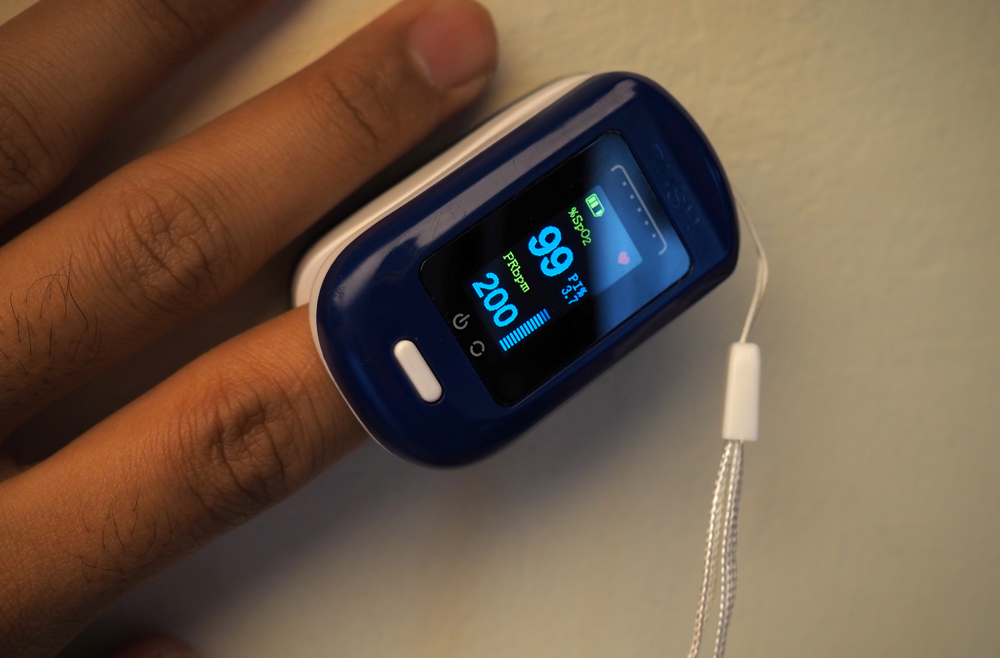
PHILADELPHIA— Using a pulse oximeter to measure oxygen levels is no better than just regularly asking patients with COVID-19 if they are short of breath, according to new research at the Perelman School of Medicine of the University of Pennsylvania. Pulse oximeters have often been applied because of concerns that patients might not notice their blood oxygen levels sliding dangerously. But people in Penn Medicine's COVID Watch program – which uses automated text messages to keep tabs on patients recovering at home – had the same outcomes whether they used oxygen-measuring devices or not. Findings from this work were published in the New England Journal of Medicine.
"Compared to remotely monitoring shortness of breath with simple automated check-ins, we showed that the addition of pulse oximetry did not save more lives or keep more people out of the hospital," said the study's co-lead author, Anna Morgan, MD, medical director of the COVID Watch program and an assistant professor of General Internal Medicine. "And having a pulse oximeter didn't even make patients feel less anxious."
COVID Watch launched at Penn Medicine in March 2020 to remotely monitor patients with COVID-19 who were well enough to stay home to recover. Twice a day for two weeks, text messages were automatically sent to these patients asking how they felt and if they were having difficulty breathing, a condition formally known as dyspnea. If patients indicated more difficulty breathing, they would be called by a nurse who would direct the patient to the ER, arrange an urgent telemedicine appointment, or suggest continued monitoring at home. More than 28,500 patients have been enrolled in the program since it came online.
"The program made it easy to identify the sickest patients who needed the hospital, and keep the others at home safely," said David Asch, MD, executive director of the Center for Health Care Innovation and a professor of Medicine, Medical Ethics and Health Policy. "The program was associated with a 68 percent reduction in mortality, saving a life approximately every three days during peak enrollment early in the pandemic."
But the question remained whether the program would be even better if it was based on the actual oxygen content of the blood rather than just whether patients felt short of breath.
"Early in the pandemic, there was a prevalent theory that oxygen levels in the blood dropped before a COVID-19 patient became symptomatic and short of breath," said study co-lead author Kathleen Lee, MD, an adjunct assistant professor of Emergency Medicine. "Detecting this earlier with a home pulse oximeter might provide an opportunity to get patients who are on the cusp of deteriorating to the hospital faster and initiate time-sensitive therapies to improve outcomes."
Using pulse oximeters was so intuitively appealing that the process got adopted even before this trial, the first randomized trial to test whether it actually worked.
"Several health systems, and even states like Vermont and countries like the United Kingdom, have integrated pulse oximetry into the routine home management of patients with COVID-19, but there's been scant evidence to show this strategy makes a difference," said the research project's principal investigator M. Kit Delgado, MD, an assistant professor of Emergency Medicine and Epidemiology.
In this study, more than 2,000 patients enrolled in COVID Watch between Nov. 29, 2020, and Feb. 5, 2021, were randomized to receive standard COVID Watch care or the same program with the addition of a pulse oximeter.
The pulse oximeter didn't make the patients any better off. The researchers found no statistical difference in the main measure of the study, the average number of days enrolled patients spent alive and out of the hospital in the 30 days after they were enrolled. For patients with pulse oximeters, the measure was 29.4 days; for those without, it was 29.5. This lack of difference held across racial lines, as there was no notable difference between outcomes for Black and white patients. This is important, as Black patients have had disproportionately worse COVID-19 mortality rates during the pandemic, and recent research has raised concerns that fingertip pulse oximeters may be less likely to detect low oxygen levels in patients with dark skin pigment compared with lighter skin pigment.
The researchers cautioned that their study examined the use of pulse oximeters amid an established program of remote monitoring, noting that patients don't have access to a system like COVID Watch or on-call clinicians, self-monitoring with pulse oximeters may still be a reasonable approach until there is evidence to the contrary.
"Overall, these findings suggest that a low-tech approach for remote monitoring systems based on symptoms is just as good as a more expensive one using additional devices. Automated text messaging is a great way for health systems to enable a small team of on-call nurses to manage large populations of patients with COVID-19," said the research project's co-principal investigator, Krisda Chaiyachati, MD, an assistant professor of Internal Medicine and now the physician lead for Value-based Care and Innovation at Verily. "There are a lot of other medical conditions where the same kind of approach might really help."
This study was funded by the Patient-Centered Outcomes Research Institute (COVID-2020C2-10830), the National Institutes of Health (K23HD090272001, K08AG065444) and the Abramson Family Foundation.






